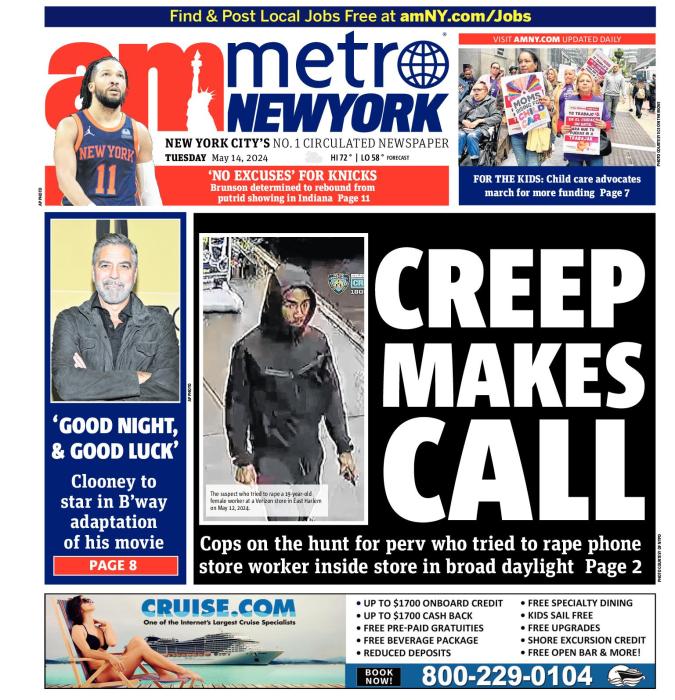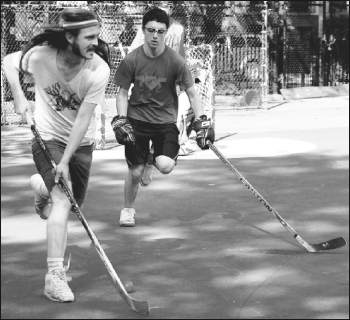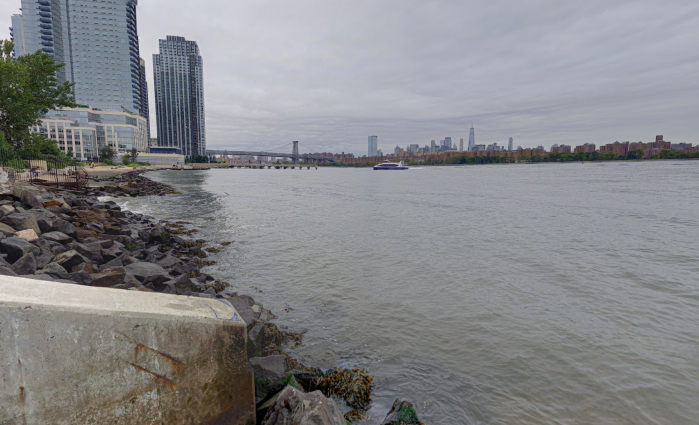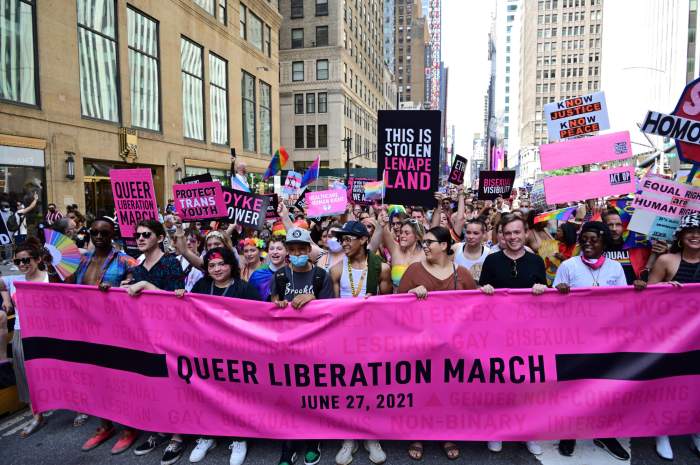By John Bayles
All sports have their heated rivalries; in baseball, you’ve got the Yankees and Red Sox; in basketball, it’s the Lakers and the Celtics. But these pale in comparison to the intense, often ugly rivalry between the Denim Demons and the Rehabs.
“The Demons suck!” yelled Kammi Moore, wearing her team’s jersey, a black T-shirt with cutoff sleeves and the word “Rehabs” in big, pink letters. “That’s all you need to know.”
Earlier in the day the Demons had bested the Rehabs, 3-2, in an overtime game, which obviously contributed to Moore’s animosity. But according to Moore, the rivalry began with some trash-talking during a game back in 2003, on the part of the Demons, she added. A player on the Rehabs then found some “pornographic pictures” on the Web, Demon players in sundry positions, and the Rehabs printed the pictures and stuck them on the backs of their jerseys for the next game. Since then, the rivalry has reached seemingly historic proportions.
“We’ve never met in the championship,” said Moore. “Last season we lost to them in the quarter-finals, but we pelted them with water balloons anyway.”
The Demons and the Rehabs are two of the 18 teams, all with equally interesting names, that make up the Blacktop Street Hockey League (B.T.S.H.) and who play their games in Tompkins Square Park on Sunday afternoons from March to October. Most of the names have stories to go along with them. The Mexican Standoffs are named after a drink at a bar frequented by the team manager. And then you have the Filthy Gorgeous, named after a Scissor Sisters song, and Cobra Kai of “The Karate Kid” fame.
Hang out at the Tompkins blacktop and you’ll hear people yelling, “Go Math!” (There’s a team named the Mathematics) and “Come on Filthy!”
But funny names aside, B.T.S.H. has become a stalwart among the recreational beer leagues that infiltrate the city’s park ball fields and blacktops during the summer. It’s nearing its tenth anniversary, and since its inception in 2000, it has expanded from six teams to 18 and expects to once again expand to 20 or 22 teams next year. There’s even a free-agent pool with players hoping to get picked up in the off-season.
The skill level ranges from nonexistent — someone who has never held a hockey stick in his or her life — to advanced, with players who’ve spent years playing minor league ice hockey.
Bob W. has been the league manager since 2002 and can always be found at the blacktop in Tompkins Square on Sundays, answering people’s questions, picking up trash and generally keeping a watchful eye over all things B.T.S.H.
Of his seven-year tenure as league manager, Bob W. said, “It’s a culture. It’s a lifestyle and it, you know, becomes your social focal point. You create so many friends and associations doing this job, and it’s really rewarding and everyone is very community minded and appreciative. Not a weekend goes by on a Sunday when I’m not thanked 25 times. And not a weekend goes by when people aren’t offering to help out in any way they can.”
B.T.S.H. is one part of the soon to be incorporated nonprofit Urban Hockey Association. Once the umbrella organization finishes the necessary paperwork to become a legitimate 501(c)(3), B.T.S.H. and its sister league, MOFO Hockey (mofohockey.org) — which plays in a rink, Moffo Rink, instead of on a blacktop, at Tanahey Park near the South Street Seaport — will be joined by a youth league that Bob W. promises will be less, er, beer oriented.
“What we’re trying to do is to start a program that we hope to grow throughout the city — an introductory youth street hockey program, free of charge,” Bob W. explained. “It will involve basic instruction, skills and strategy. Physical fitness obviously will be part of it, and we hope to teach the kids goods sportsmanship and teamwork as well.”
He said the project will involve a mix of skills training and scrimmaging and will be totally separate from B.T.S.H. Bob W. said the youth league’s starting date will be sometime in the fall.
B.T.S.H., and MOFO too, is hockey in sneakers, not rollerblades or in-line skates. There’s a ball instead of a puck and there is no body checking. B.T.S.H. has other rules, such as always having at least two girls playing on the blacktop for each team. And the female factor is essential to B.T.S.H. The league was actually founded by two women; one has since moved to Los Angeles and the other stepped back to raise a child. In Bob W.’s eyes, having the girls involved is one way of making sure the machismo is kept to minimum.
“It forces the teams to incorporate the women in a meaningful way,” he said. “And it lessens the aggression. Obviously, some of the women play very aggressively. But keeping women in the mix reminds the men not to be jerks.”
Because of the two-women rule, it’s currently easier to get into the league if you’re a female. Ashley McMass is one example, currently playing in her first B.T.S.H. season for Filthy Gorgeous. She played Division I field hockey for Columbia, just graduated and is now looking for a job. Haanwa is another female and is on the Mexican Standoff. She’s been playing since 2002.
“It’s great hanging out with all these wonderful people,” McMass said. “And it’s nice exercise. It’s not like I can afford a gym membership.”
That seems to be the combination that lures most of the players into B.T.S.H.: It’s an easy way to meet people from different backgrounds — there are freelance artists, engineers, physicists, musicians and doctors — and it’s a fun way to stay in somewhat decent shape.
Eli Kazin works in advertising and plays on the Mathematics; when the team was formed, one of the founders was in grad school for physics. Their team jerseys are gray T-shits and their logo is the variable “X” under the square-root sign. Kazin also manages the B.T.S.H. Web site (BTSH.org). His only hockey experience prior to B.T.S.H. was gym floor hockey in high school.
“It’s the only outdoor, athletic thing I do,” he noted.
Kazin said it’s a fun way to fill the weekends; athletic activity and beer drinking when there are no football games to watch on television. But Kazin, along with Bob W., also mentioned the competiveness of the league. While it’s all fun and games, some teams certainly want to be in the championship when all is said and done.
“Any time someone is keeping score, there is competition and nobody wants to be on the lower side of that score. That’s just a fact of life,” said Bob W.
Kazin said there’s the occasional suspension and players get tossed out of the games for breaking the rules or for being stupid. When it comes to wanting to win, he echoed Bob W.’s remarks:
“It’s just an aspect of human nature. When you’re competing and keeping score, people are going to be competitive. No one wants to show up and lose every week.”
Another night, de Kooning recalled overhearing Clement Greenberg and another art critic talking at the Cedar. When Greenberg said Pollock was the greatest painter of the day, de Kooning turned around and slapped the critic in the face. The men jumped on each other and started throwing punches, until Rosenfeld and others stepped in to separate them.
Rosenfeld also recalled a deal he witnessed between Kline and an art collector, in which Kline agreed to trade several of his mammoth black-and-white paintings to the collector in exchange for a brand-new Ferrari shipped directly from Italy. Kline and the art collector shook on it, and shortly thereafter Kline drove up to the Cedar in his new Ferrari, which Rosenfeld said became a regular fixture out front.
As Rosenfeld described the all-night loft parties, the artists who grew rich overnight and the sudden death of Andy Warhol, he shook his head.
“Those were moments, they were like a movie script,” Rosenfeld said. “Everybody was pretty wild.”
“You’ll never have a scene like that again,” Rosenfeld added. “That was truly like a renaissance…a modern renaissance. Everything went dead after that, as far as I’m concerned. The whole art scene kind of died after abstract expressionism.”
Rosenfeld isn’t an abstract expressionist himself, because he felt that type of work had already been done. Rosenfeld’s work has a similar intensity but is representational and often tells a story. He takes inspiration from current events and his own observations, and much of his work makes a political statement.
“I never really had any goals,” Rosenfeld said. “The only goal is what I was doing immediately.”
Rosenfeld’s artwork has drawn many acolytes, including Danny Simmons, an artist and gallery owner who was recently named chairperson of the New York State Council on the Arts, and who is also Russell Simmons’ brother.
“Len’s work is direct,” Simmons said by phone this week. “You get a certain feeling about the artist, what he thinks about and what he feels about it.”
Simmons has shown Rosenfeld’s work several times, including a solo exhibit of post-9/11 paintings that reflect Rosenfeld’s memories of the day, which include seeing people jump from the smoking towers. After 9/11, Rosenfeld did a series of paintings depicting pink angels floating against a background of multicolored dots, reflecting the confusion over how to “connect the dots” of what happened that day.
Simmons thinks Rosenfeld is under-recognized in the art world because he doesn’t promote himself the way other artists do.
“He spent his time being an artist,” Simmons said. “Len just does the work, and he’s really successful with the work.”
Rosenfeld’s longtime friend, the artist Vernita Nemec, likes Rosenfeld’s work because it is personal.
“He’s got a very aggressive approach to reality,” Nemec said. “It’s never abstract. There’s always a kind of strength.”
Rosenfeld’s projects often start with big ideas — like the General David Petraeus quote referring to the Iraq War, “Tell me how this ends?” — but his process remains focused on the act of creating art.
As he works, Rosenfeld said, “I’m not feeling anything else but what it requires to do the painting or the drawing.”
Asked what he wanted to do next, Rosenfeld at first turned glum.
“I don’t know if I’m going to do anything next,” he said. But after a few minutes Rosenfeld perked up, and interrupted another thought to add, “I’d like to do something very big, like the size of the wall,” he said. “But I don’t know what it would be exactly.”
Rosenfeld had heart surgery Tuesday, several days after the interview, to replace his aortic valve. The next day, his wife Janet Hoffman said he was recovering as well as could be expected.
Rosenfeld’s memory is still strong, but it sometimes requires a jump-start, usually provided by Hoffman, a lawyer. During the interview last week, Hoffman, 63, encouraged her husband to tell a reporter how he made his early railroad drawings.
“How did I make them?” Rosenfeld asked.
“Well, you tell her,” Hoffman replied.
“I don’t know — I’m asking you how I made them,” Rosenfeld said.
“You remember,” Hoffman said, and it turned out that he did. Rosenfeld paused, then launched into the narrative of his 1957 railroad drawings: how he perched on elevated train stations in Brooklyn and Queens, sketching furiously with black crayon, using sharp lines to render the tracks weaving between the buildings.
Several of the drawings are on display now in the Van Der Plas Gallery on Pier 17 until Aug. 28.
“It just comes from his soul,” said Adriaan van der Plas, who has owned the Seaport gallery for 18 years. The railroad drawings are among Rosenfeld’s strongest work because of their immediacy, van der Plas said.
Rosenfeld also has several upcoming exhibits, including a show opening Oct. 15 at Salomon Arts in Tribeca and one opening mid-September at Sabay, a Thai restaurant in Jackson Heights.
Rosenfeld was born in Brooklyn in 1926 and was drafted to serve in World War II while still in high school. During the war, while posted in Guam, he filled the walls of a warehouse with “lascivious, pornographic drawings,” as he put it. When a general discovered the drawings during a routine inspection, Rosenfeld expected to be reprimanded. But instead, the general asked if he could take some of the drawings to keep.
“I said, ‘Sure, take what you want,’” Rosenfeld said.
After the war, Rosenfeld attended The Art Students League on 57th St. and then spent the next decade alternating between collecting unemployment and working in odd jobs like framing and delivering food. Rosenfeld also married a woman he met at art school and they had two daughters together, but the marriage didn’t last. All the while, Rosenfeld continued creating art.
His first break came in 1980 when he convinced Ivan Karp, owner of the OK Harris Gallery in Soho, to show some of his large minimalist paintings. Karp’s support immediately brought in buyers and also helped Rosenfeld get shows elsewhere.
Rosenfeld has lived in Lower Manhattan for over 40 years and can’t imagine living elsewhere.
“Why did I stay?” he said, echoing a reporter’s query. “It was never a question of that.”
Rosenfeld lived and worked on Forsyth St. between Broome and Grand Sts. from 1958 until 1991. The neighborhood inspired his “hookers and pimps” series in the 1980s, when the material was literally on his doorstep.
“Day and night we had hookers,” Rosenfeld said, cracking a smile. “The hookers were alright, but the pimps could be pretty rough.”
Rosenfeld frequently saw prostitutes and johns, including a rabbi one time having sex in Sara D. Roosevelt Park across the street from his apartment.
Rosenfeld had a standing joke with the prostitutes who hung out in front of his apartment.
“One of them would come over to me and she’d grab me — by the balls — and she’d say, ‘How ’bout a date, Pop?’” Rosenfeld said, laughing. “And they’d all wait for me [to respond] and I would say, ‘Stay cool baby.’ Every morning. And they would all start laughing — that was like the morning joke.”
The neighborhood changed when Chinese immigrants arrived in droves. More children were around and the prostitutes disappeared. Rosenfeld’s landlord tried to throw him out, but he won a court battle to stay.
Still, when Rosenfeld married for the second time in 1991, he realized it was time to move. Hoffman, his new wife, deserved better quarters than a shared hallway bathroom, and they settled on a live/work space in the Financial District, where they have lived ever since.
The rabbi who married the couple asked why they didn’t just move up to Hoffman’s apartment on E. 79th St.
Rosenfeld explained his reasoning: “I got five grapefruits for a dollar Downtown,” he recalled telling the rabbi. “You had to spend a dollar to get one grapefruit in her neighborhood Uptown. The rabbi said, ‘Oh, I understand.’”
Rosenfeld’s work is on display at the Van Der Plas Gallery on Pier 17 through Aug. 28, open 10 a.m. to 9 p.m. daily (vanderplasgallery.com, 212-227-8983).

















